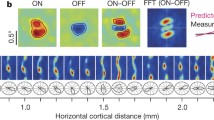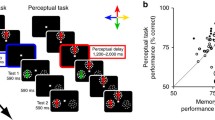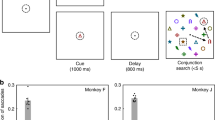Summary
The topographic distribution and organization of visual neurons in the prefrontal cortex was examined in alert monkeys. The animal was trained to fixate straight ahead onto a tinty, dim light spot. While he was fixating, we presented a stationary second light spot (RF spot) at various locations in the visual field and examined unit responses of the prefrontal neurons to the RF-spot stimulus. Many prefrontal neurons, especially those located in the relatively superficial layers of the cortex, responded with a phasic and/or tonic activation to the RF spot illuminating a limited extent of the visual field, a receptive field (RF) being so determined. The visual neurons were found to be widely distributed in the prearcuate and inferior dorsolateral areas. One hemisphere mainly represented the contralateral visual field. According to the location of the neurons in these areas, their visual properties varied with respect to RF eccentricity from the fovea and in size. The neurons located in the lateral part of the areas and close to the inferior arcuate sulcus had relatively small RFs representing the foveal and parafoveal regions. When the recording site was moved medially, the RFs became eccentric from the fovea and were larger. Then, the neurons located between the caudal end of the principal sulcus and the arcuate sulcus had RFs with a considerable eccentricity. The size of the RF became progressively larger for anteriorly located neurons and this occurred generally without a change in RF eccentricity. The visual neurons were not organized on a regular pattern in the cortex with regard to their RF direction (vector angle) from the foveal region. From these observations, we conclude, first, that the prearcuate and inferior dorsolateral areas of the prefrontal cortex are functionally differentiated so that the lateral area's function is related to central vision, while that of the medial area to ambient vision. Second, the RF representation on the cortex with loss of the vector relation may generate an interaction between separate objects in visual space and may subserve the control of attention performance.
Similar content being viewed by others
References
Akert K (1964) Comparative anatomy of frontal cortex and thalamofrontal connections. In: Warren JM, Akert K (eds) The frontal granular cortex and behavior. McGraw-Hill, New York, pp 372–396
Azuma M, Suzuki H (1981) Visual neurons in the monkey prefrontal cortex. J Physiol Soc Jpn 43: 322
Barbas H, Mesulam M-M (1981) Organization of afferent input to subdivisions of area 8 in the rhesus monkey. J Comp Neurol 200: 407–431
Benevento LA, Fallon JH (1975) The ascending projections of the superior colliculus in the rhesus monkey (Macaca mulatta). J Comp Neurol 160: 339–362
Bignall KE, Imbert M (1969) Polysensory and cortico-cortical projections to frontal lobe of squirrel and rhesus monkeys. Electroencephalogr Clin Neurophysiol 26: 206–215
Bizzi E, Schiller PH (1970) Single unit activity in the frontal eye fields of unanesthetized monkeys during eye and head movement. Exp Brain Res 10: 151–158
von Bonin G, Bailey P (1947) The neocortex of macaca mulatta. The University of Illinois Press, Urbana
Bushnell MC, Goldberg ME, Robinson DL (1981) Behavioral enhancement of visual responses in monkey cerebral cortex. I. Modulation in posterior parietal cortex related to selective visual attention. J Neurophysiol 46: 755–772
Chavis DA, Pandya DN (1976) Further observations on corticofrontal connections in the rhesus monkey. Brain Res 117: 369–386
Crowne DP, Yeo CH, Russel SI (1981) The effects of unilateral frontal eye field lesions in the monkey: visual-motor guidance and avoidance behavior. Behav Brain Res 2: 165–187
Gattass R, Gross CG (1981) Visual topography of striate projection zone (MT) in posterior superior temporal sulcus of the macaque. J Neurophysiol 46: 621–638
Goldberg ME, Bushnell MC (1981) Behavioral enhancement of visual responses in monkey cerebral cortex. II. Modulation in frontal eye fields specifically related to saccades. J Neurophysiol 46: 773–787
Gross CG, Rocha-Miranda CE, Bender DB (1972) Visual properties of neurons in inferotemporal cortex of the macaque. J Neurophysiol 35: 96–111
Harting JK, Huerta MF, Frankfurter AJ, Strominger NL, Royce GJ (1980) Ascending pathways from the monkey superior colliculus: an autoradiographic analysis. J Comp Neurol 192: 853–882
Hubel DH, Wiesel TN (1968) Receptive fields and functional architecture of monkey striate cortex. J Physiol (Lond) 195: 215–243
Jacobson S, Trojanowski JQ (1977) Prefrontal granular cortex of the rhesus monkey. I. Intrahemispheric cortical afferents. Brain Res 132: 209–233
Jones EG, Powell TPS (1970) An anatomical study of converging sensory pathways within the cerebral cortex of the monkey. Brain 93: 793–820
Kuypers HGJM, Szwarcbart MK, Mishkin M, Rosvold HE (1965) Occipitotemporal corticocortical connections in the rhesus monkey. Exp Neurol 11: 245–262
Mays LE, Sparks DL (1980) Dissociation of visual and saccaderelated responses in superior colliculus neurons. J Neurophysiol 43: 207–232
Mikami A, Ito S, Kubota K (1982) Visual response properties of dorsolateral prefrontal neurons during visual fixation task. J Neurophysiol 47: 593–605
Mohler CW, Goldberg ME, Wurtz RH (1973) Visual receptive fields of frontal eye field neurons. Brain Res 61: 385–389
Moors J, Vendrick AJH (1979) Responses of single units in the monkey superior colliculus to stationary flashing stimuli. Exp Brain Res 35: 333–347
Motter BC, Mountcastle VB (1981) The functional properties of the light-sensitive neurons of the posterior parietal cortex studied in waking monkeys: foveal sparing and opponent vector organization. J Neurosci 1: 3–26
Mountcastle VB, Andersen RA, Motter BC (1981) The influence of attentive fixation upon the excitability of the light-sensitive neurons of the posterior parietal cortex. J Neurosci 1: 1218–1235
Pigarev IN, Rizzolatti G, Scandolara C (1979) Neurons responding to visual stimuli in the frontal lobe of macaque monkeys. Neurosci Lett 12: 207–212
Rizzolatti G, Scandolara C, Matelli M, Gentilucci M (1981a) Afferent properties of periarcuate neurons in macaque monkeys. I. Somatosensory responses. Behav Brain Res 2: 125–146
Rizzolatti G, Scandolara C, Matelli M, Gentilucci M (1981b) Afferent properties of periarcuate neurons in macaque monkeys. II. Visual responses. Behav Brain Res 2: 147–163
Robinson DL, Goldberg ME, Stanton GB (1978) Parietal association cortex in the primate: sensory mechanisms and behavioral modulations. J Neurophysiol 41: 910–932
Schiller PH, Koerner F (1971) Discharge characteristics of single units in superior colliculus of the alert rhesus monkey. J Neurophysiol 34: 920–936
Schiller PH, True SD, Conway JL (1980) Deficits in eye movements following frontal eye-field and superior colliculus ablations. J Neurophysiol 44: 1175–1189
Seltzer B, Pandya DN (1980) Converging visual and somatic sensory cortical input to the intraparietal sulcus of the rhesus monkey. Brain Res 192: 339–351
Suzuki H, Azuma M (1976) A glass-insulated “Elgiloy” microelectrode for recording unit activity in chronic monkey experiments. Electroencephalogr Clin Neurophysiol 41: 93–95
Suzuki H, Azuma M (1977) Prefrontal neuronal activity during gazing at a light spot in the monkey. Brain Res 126: 497–508
Suzuki H, Azuma M (1979) A method for the accurate localization of recording sites in chronic monkey experiments. In: Ito M (ed) Integrative control function of the brain. Kodansha Scientific, Tokyo (vol II, pp 405–407)
Suzuki H, Azuma M, Yumiya H (1979) Stimulus and behavioral factors contributing to the activation of monkey prefrontal neurons during gazing. Jpn J Physiol 29: 481–499
Trojanowski JQ, Jacobson S (1974) Medial pulvinar afferents to frontal eye fields in rhesus monkey demonstrated by horseradish peroxidase. Brain Res 80: 395–411
Walker AE (1940) A cytoarchitectual study of the prefrontal area of the macaque monkey. J Comp Neurol 73: 59–86
Wollberg Z, Sela J (1980) Frontal cortex of the awake squirrel monkey: responses of single cells to visual and auditory stimuli. Brain Res 198: 216–220
Wurtz RH (1969) Visual receptive fields of striate cortex neurons in awake monkeys. J Neurophysiol 32: 727–742
Wurtz RH, Albano JE (1980) Visual-motor function of the primate superior colliculus. Ann Rev Neurosci 3: 189–226
Wurtz RH, Goldberg ME (1972) Activity of superior colliculus in behaving monkey. III. Cells discharging before eye movements. J Neurophysiol 35: 575–586
Wurtz RH, Mohler CW (1976) Enhancement of visual responses in monkey striate cortex and frontal eye fields. J Neurophysiol 39: 766–772
Author information
Authors and Affiliations
Additional information
Supported by Grant-in-aid for Scientific Research 444022, 587030 and Special Project Research Grant 56121001 from the Ministry of Education, Science and Culture of Japan
Rights and permissions
About this article
Cite this article
Suzuki, H., Azuma, M. Topographic studies on visual neurons in the dorsolateral prefrontal cortex of the monkey. Exp Brain Res 53, 47–58 (1983). https://doi.org/10.1007/BF00239397
Received:
Revised:
Issue Date:
DOI: https://doi.org/10.1007/BF00239397




